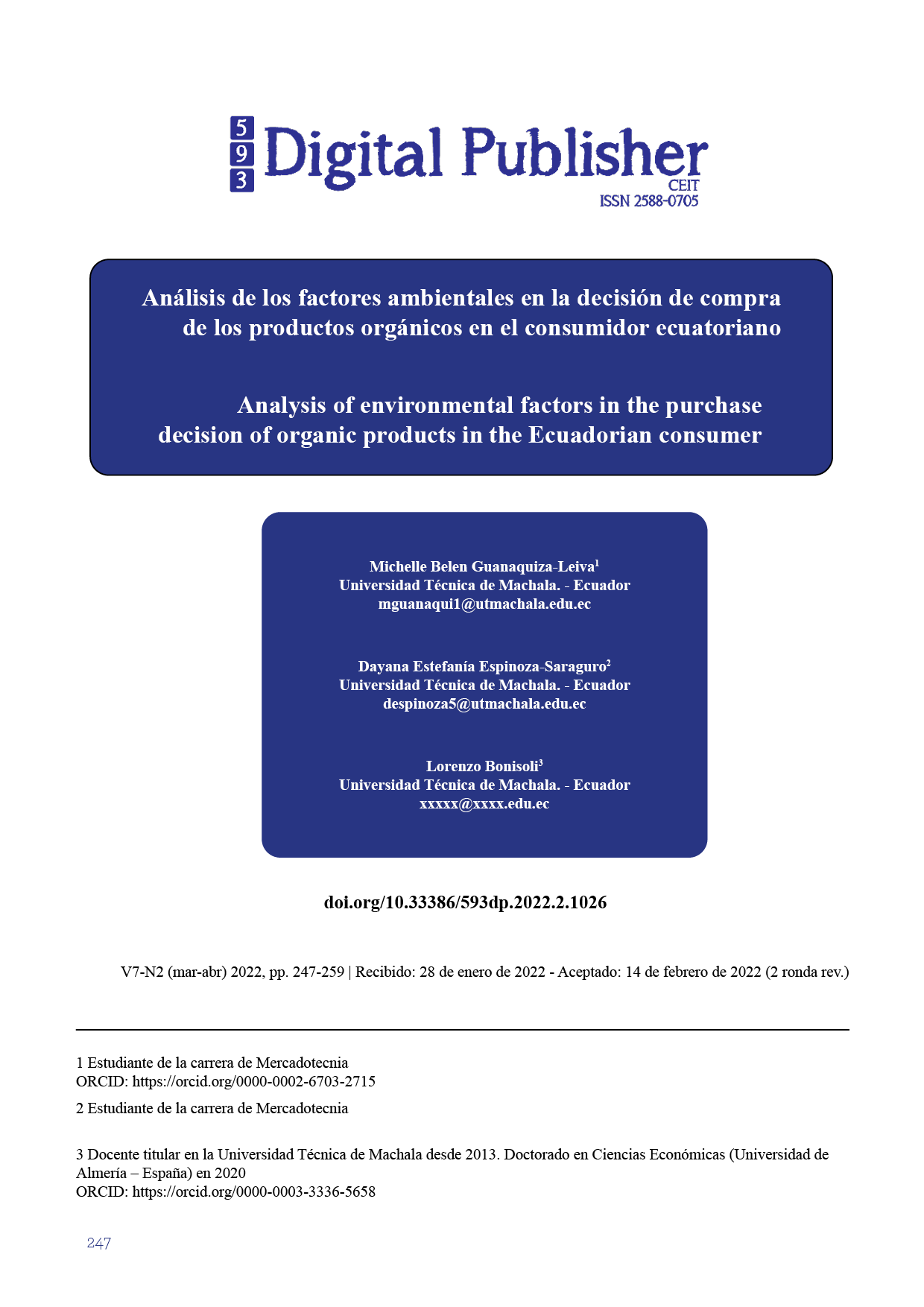Analysis of environmental factors in the purchase decision of organic products in the Ecuadorian consumer
Main Article Content
Abstract
The objective of this research is to analyze whether environmental factors influence the purchase decision of organic products of the Ecuadorian consumer using the theory of planned behavior. The methodology for the study of environmental factors in the purchase decision of the Ecuadorian consumer is through a non-probabilistic sample, applied to 391 people, which has been developed with the snowball method using a model of Structured survey with the Likert scale, with the help of the structural equation model, where key information is collected about the influence of environmental factors in the purchase of organic products by the consumer in Ecuador. The results confirmed the acceptance of the hypotheses raised in the research, showing that environmental factors positively influence the decision to purchase organic products. In addition, the variable of purchase intention and knowledge of the organic product are strong indicators for the inclination in the decision to purchase organic products. From this information, important data can be obtained as a basis for future research.
Downloads
Article Details

This work is licensed under a Creative Commons Attribution-NonCommercial-ShareAlike 4.0 International License.
1. Derechos de autor
Las obras que se publican en 593 Digital Publisher CEIT están sujetas a los siguientes términos:
1.1. 593 Digital Publisher CEIT, conserva los derechos patrimoniales (copyright) de las obras publicadas, favorece y permite la reutilización de las mismas bajo la licencia Licencia Creative Commons 4.0 de Reconocimiento-NoComercial-CompartirIgual 4.0, por lo cual se pueden copiar, usar, difundir, transmitir y exponer públicamente, siempre que:
1.1.a. Se cite la autoría y fuente original de su publicación (revista, editorial, URL).
1.1.b. No se usen para fines comerciales u onerosos.
1.1.c. Se mencione la existencia y especificaciones de esta licencia de uso.
References
Ab Hamid, M. R., Sami, W., & Mohmad Sidek, M. H. (2017). Discriminant Validity Assessment: Use of Fornell & Larcker criterion versus HTMT Criterion. Journal of Physics. Conference Series, 890(1), 012163. https://doi.org/10.1088/1742-6596/890/1/012163
Ajzen, I. (1985). From Intentions to Actions: A Theory of Planned Behavior. En Action Control (pp. 11-39). https://doi.org/10.1007/978-3-642-69746-3_2
Ajzen, I. (1991). The Theory of Planned Behavior. Organizational behavior and human decision processes, 50(2), 179-211. https://doi.org/10.1016/0749-5978(91)90020-T
Ajzen, I. (2002). Perceived behavioral control, self-efficacy, locus of control, and the theory of planned Behavior1. Journal of Applied Social Psychology, 32(4), 665-683. https://doi.org/10.1111/j.1559-1816.2002.tb00236.x
Ajzen, I., & Fishbein, M. (1975). A Bayesian analysis of attribution processes. Psychological bulletin, 82(2), 261-277. https://doi.org/10.1037/h0076477
Ajzen, I., & Fishbein, M. (2000). Attitudes and the Attitude-Behavior Relation: Reasoned and Automatic Processes. European Review of Social Psychology, 11(1), 1-33. https://doi.org/10.1080/14792779943000116
Ajzen, I., & Madden, T. J. (1986). Prediction of goal-directed behavior: Attitudes, intentions, and perceived behavioral control. Journal of experimental social psychology, 22(5), 453-474. https://www.sciencedirect.com/science/article/pii/0022103186900454
Arli, D., Tan, L. P., Tjiptono, F., & Yang, L. (2018). Exploring consumers’ purchase intention towards green products in an emerging market: The role of consumers’ perceived readiness. International Journal of Consumer Studies, 42(4), 389-401. https://doi.org/10.1111/ijcs.12432
Bagozzi, R. P., Yi, Y., & Phillips, L. W. (1991). Assessing Construct Validity in Organizational Research. Administrative science quarterly, 36(3), 421-458. https://doi.org/10.2307/2393203
Biedenweg, K., Monroe, M. C., & Oxarart, A. (2013). The importance of teaching ethics of sustainability. En International Journal of Sustainability in Higher Education (Vol. 14, Número 1, pp. 6-14). https://doi.org/10.1108/14676371311288912
Blanco-González, A., Martín-Armario, E., & Mercado Idoeta, C. (2013). La influencia de las actitudes en la intención de compra del coleccionista. Revista Europea de Dirección y Economía de la Empresa, 22(2), 61-68. https://doi.org/10.1016/j.redee.2012.07.007
Cacek, T., & Langner, L. L. (1986). The economic implications of organic farming. American Journal of Alternative Agriculture, 1(1), 25-29. https://doi.org/10.1017/S0889189300000758
Chen, M.-F. (2020). The impacts of perceived moral obligation and sustainability self‐identity on sustainability development: A theory of planned behavior purchase intention model of sustainability‐labeled coffee and the moderating effect of climate change skepticism. Business Strategy and the Environment, 29(6), 2404-2417. https://doi.org/10.1002/bse.2510
Cronbach, L. J. (1951). Coefficient alpha and the internal structure of tests. Psychometrika, 16(3), 297-334. https://doi.org/10.1007/BF02310555
Davison, A. C., Hinkley, D. V., & Young, G. A. (2003). Recent Developments in Bootstrap Methodology. Statistical science: a review journal of the Institute of Mathematical Statistics, 18(2), 141-157. http://www.jstor.org/stable/3182844
De Wit, J., & Verhoog, H. (2007). Organic values and the conventionalization of organic agriculture. NJAS - Wageningen Journal of Life Sciences, 54(4), 449-462. https://doi.org/10.1016/S1573-5214(07)80015-7
Etikan, I., Alkassim, R., & Abubakar, S. (2016). Comparision of snowball sampling and sequential sampling technique. Biometrics and Biostatistics International Journal, 3(1), 55. https://www.academia.edu/download/42569290/BBIJ-03-00055.pdf
García-Mira, R., & Real, J. E. (2001). Dimensiones de preocupación ambiental: una aproximación a la hipermetropía ambiental. Estudios de psicologia, 22(1), 87-96. https://doi.org/10.1174/021093901609622
Ghasemy, M., Teeroovengadum, V., Becker, J.-M., & Ringle, C. M. (2020). This fast car can move faster: a review of PLS-SEM application in higher education research. Higher Education, 80(6), 1121-1152. https://doi.org/10.1007/s10734-020-00534-1
González, A., & Amérigo, M. (1998). La preocupación ambiental como función de valores y creencias. Revista de Psicología Social, 13(3), 453-461. https://doi.org/10.1174/021347498760349706
Haering, A., Dabbert, S., Offermann, F., & Nieberg, H. (2001). Benefits of organic farming for society. European Conference--Organic Good and Farming--Towards Partnership and Action in Europe, Copenhagen, Denmark, 10-11. https://citeseerx.ist.psu.edu/viewdoc/download?doi=10.1.1.194.6594&rep=rep1&type=pdf
Hair, J. F., Hult, T. G., Ringle, C. M., & Sarstedt, M. (2021). A Primer on Partial Least Squares Structural Equation Modeling (PLS-SEM). SAGE.
Hayduk, L. A., & Littvay, L. (2012). Should researchers use single indicators, best indicators, or multiple indicators in structural equation models? BMC Medical Research Methodology, 12, 159. https://doi.org/10.1186/1471-2288-12-159
Hsu, C.-L., & Chen, M.-C. (2014). Explaining consumer attitudes and purchase intentions toward organic food: Contributions from regulatory fit and consumer characteristics. Food quality and preference, 35, 6-13. https://doi.org/10.1016/j.foodqual.2014.01.005
Jaiswal, D., & Kant, R. (2018). Green purchasing behaviour: A conceptual framework and empirical investigation of Indian consumers. Journal of Retailing and Consumer Services, 41, 60-69. https://doi.org/10.1016/j.jretconser.2017.11.008
LaDuke, W. (1994). Traditional ecological knowledge and enviromental futures. Colo. J. Int’l Envtl. L. & Pol'y, 5, 127. https://heinonline.org/hol-cgi-bin/get_pdf.cgi?handle=hein.journals/colenvlp5§ion=10
Lai, C. K. M., & Cheng, E. W. L. (2016). Green purchase behavior of undergraduate students in Hong Kong. The Social science journal, 53(1), 67-76. https://doi.org/10.1016/j.soscij.2015.11.003
Maichum, K., Parichatnon, S., & Peng, K.-C. (2016). Application of the extended theory of planned behavior model to investigate purchase intention of green products among Thai consumers. Sustainability: Science Practice and Policy, 8(10), 1077. https://doi.org/10.3390/su8101077
Miller, G. T., de León Rodríguez, I., & Velázquez, V. G. (1994). Ecología y medio ambiente: introducción a la ciencia ambiental, el desarrollo sustentable y la conciencia de conservación del planeta Tierra. Grupo Editorial Iberoamérica. http://www.sidalc.net/cgi-bin/wxis.exe/?IsisScript=PLAFOR.xis&method=post&formato=2&cantidad=1&expresion=mfn=000799
Miniard, P. W., & Cohen, J. B. (1981). An examination of the Fishbein-Ajzen behavioral-intentions model’s concepts and measures. Journal of experimental social psychology, 17(3), 309-339. https://doi.org/10.1016/0022-1031(81)90031-7
Muller Perez, J., Amezcua Nunez, J., & Muller Perez, S. (2021). Intención de compra de productos verdes de acuerdo con la Teoría del Comportamiento Planeado: Incorporación de la obligación moral al modelo (Intention to Purchase Green Products According to the Theory of Planned Behaviour: Incorporation of the Moral Obligation to the Model). RAN-Revista Academia & Negocios, 7(1). https://papers.ssrn.com/sol3/papers.cfm?abstract_id=3778100
Okpiaifo, G., Durand-Morat, A., West, G. H., Nalley, L. L., Nayga, R. M., Jr, & Wailes, E. J. (2020). Consumers’ preferences for sustainable rice practices in Nigeria. Global Food Security, 24(100345), 100345. https://doi.org/10.1016/j.gfs.2019.100345
Ortiz, D. A., & Flores, M. (2008). Consumo de productos orgánicos/agroecológicos en los hogares ecuatorianos. VECO, Quito, Ecuador. https://www.siicex.gob.pe/siicex/documentosportal/alertas/documento/doc/63780450radBF21D.pdf
Salama, A. M. (2007). Sustainability/Trans-disciplinarity: A concern for people and environments between confusing terminology and outdated approaches. INTBAU: International Network for Traditional Building, Architecture, & Urbanism, I, 20. https://www.intbau.org/wp-content/uploads/2014/10/SustainabilityTrans-disciplinarity.pdf
Salgado-Beltrán, L., & Beltrán-Morales, L. F. (2011). Factores que influyen en el consumo sustentable de productos orgánicos en el noroeste de México. Universidad y ciencia, 27(3), 265-279. http://www.scielo.org.mx/scielo.php?pid=S0186-29792011000300003&script=sci_arttext
Salgado Beltrán, L., Subirá Lobera, M. E., & Beltrán Morales, L. F. (2009). Consumo orgánico y conciencia ambiental de los consumidores. Problemas del desarrollo, 40(157), 189-199. http://www.scielo.org.mx/scielo.php?script=sci_arttext&pid=S0301-70362009000200008
Saucedo Estrada, H. K. (2018). Medición de la intención de emprendedores universitarios empleando ecuaciones estructurales. Revista Investigación y Negocios, 11(18), 52-63. http://www.scielo.org.bo/scielo.php?pid=S2521-27372018000200006&script=sci_abstract&tlng=en
Siderer, Y., Maquet, A., & Anklam, E. (2005). Need for research to support consumer confidence in the growing organic food market. Trends in Food Science & Technology, 16(8), 332-343. https://doi.org/10.1016/j.tifs.2005.02.001
Tenenhaus, M., Vinzi, V. E., Chatelin, Y.-M., & Lauro, C. (2005). PLS path modeling. Computational statistics & data analysis, 48(1), 159-205. https://doi.org/10.1016/j.csda.2004.03.005
Thompson, G. D. (1998). Consumer Demand for Organic Foods: What We Know and What We Need to Know. American journal of agricultural economics, 80(5), 1113-1118. https://doi.org/10.2307/1244214
Vitousek, P. M. (1994). Beyond global warming: Ecology and global change. Ecology, 75(7), 1861-1876. https://doi.org/10.2307/1941591
Wang, H., Ma, B., & Bai, R. (2019). How Does Green Product Knowledge Effectively Promote Green Purchase Intention? Sustainability: Science Practice and Policy, 11(4), 1193. https://doi.org/10.3390/su11041193
White, R. (2021). Global Harms and the Natural Environment. En P. Davies, P. Leighton, & T. Wyatt (Eds.), The Palgrave Handbook of Social Harm (pp. 89-114). Springer International Publishing. https://doi.org/10.1007/978-3-030-72408-5_5
Yang-Wallentin, F., Schmidt, P., & Davidov, E. (2004). Is there any interaction effect between intention and perceived behavioral control. Methods of. https://www.researchgate.net/profile/Fan-Wallentin/publication/29750099_Is_There_Any_Interaction_Effect_Between_Intention_and_Percieved_Behavioral_Control/links/567270eb08ae3aa2fcf0b947/Is-There-Any-Interaction-Effect-Between-Intention-and-Percieved-Behavioral-Control.pdf
Yu, T.-Y., Yu, T.-K., & Chao, C.-M. (2017). Understanding Taiwanese undergraduate students’ pro-environmental behavioral intention towards green products in the fight against climate change. Journal of cleaner production, 161, 390-402. https://www.sciencedirect.com/science/article/pii/S0959652617310557
Zepeda, L., & Li, J. (2007). Characteristics of Organic Food Shoppers. Journal of Applied Agricultural Economics, 39(1), 17-28. https://doi.org/10.1017/S1074070800022720




